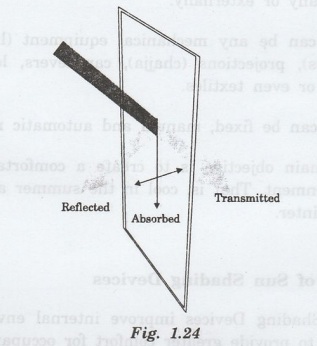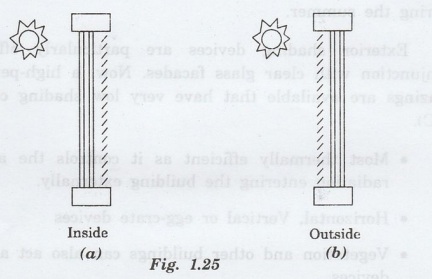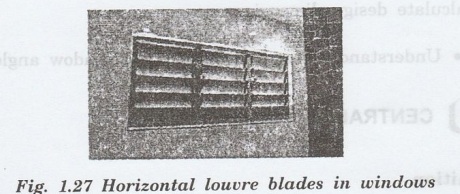Physics For Civil Engineering: Unit I: Thermal Application
Shading Devices
Definition, Functions, Types, Designing | Thermal Application
A shading device is a component of a window and facade that protects space from direct sunlight, over heating, glare and provides increased day light, privacy or view to the outside
SHADING DEVICES
A
shading device is a component of a window and facade that protects space from
direct sunlight, over heating, glare and provides increased day light, privacy
or view to the outside.
Functions
of shading devices.
• Well-designed sun control and shading
devices dramatically reduce building peak heat gain and cooling requirements.
• These devices also improve the natural
lighting quality of building interiors.
• Shading devices can improve user
visual comfort by 991d controlling glare and reducing contrast ratios.
• Some shading devices can also function
as They are called as light shelves, which bounce natural day light deep into
building interiors.
• The use of shading devices is an
important aspect of many energy-efficient building design.
• Sun shading devices inhibit the solar
radiation (block, allow, etc.) incident on a building. They are used either
internally or externally.
• They can be any mechanical equipment
(like dynamic facades), projections (chajja), cantilevers, louvers, fins,
jaalis or even textiles.
• They can be fixed, manual and
automatic movable.
• The main objective is to create a
comfortable internal environment. That is, cool in the summer and warm in the
winter.
Importance
of Sun Shading Devices
• Sun Shading Devices improve internal
environment in order to provide greater comfort for occupants.
• Use of shading device can improve
building energy performance.
• Shading devices can prevent glare
(causing discomfort or disability of vision).
• They increase useful daylight
availability.
• They provide a sense of security
(internal sun shading devices like curtains help to beautify internal space and
create a sense of privacy).
Solar
shading
When sunlight hits a pane of glass, it
splits into three components
Reflected:
no effect on heating.
Absorbed:
glass heats up which would transfer heat by conduction and also emits heat
(and)
Transmitted:
Heat up surface behind it.
The proportion between the three
components is determined by the 'angle
of incidence' and by the type of glazing.

For most types of glazing, the
transmitted component is very small if the angle of incidence is larger than
45° from the normal to the glazing.
If the angle is more than 60°, most of
the radiation is reflected.
1. Types of shading devices
Shading devices are classified into two
types viz. (Fig. 1.25)
On the basis of their position in a
building:
1. Internal shading devices
2. External shading devices
1. Internal shading devices
• Internal shading devices such as
curtains, vertical blinds can reduce heat energy passing through a window. The
effectiveness of these shading devices depend on their ability to reflect the
incoming solar radiations back through the window. (Fig. 1.25 (a))
• Light coloured drapes or blinds lined
with light coloured materials are more effective than the dark coloured shading
devices.
• The major disadvantage of internal
device is that they awobar trap heat on the interior of the glass.

• Internal shading devices should not
block the natural ventilation.
• Limit the glare resulting from solar
radiation.
• Usually the adjustable and allow
occupants to regulate the amount of direct light entering their space.
2. External shading device
Overhangs, vertical fins are examples of
external shading devices. They can also reduce the amount of solar heat energy
passing through a window. (Fig. 1.25 (b)) de lan
They can be used to reduce the area of
the glass surface i.e, actually impacted by the sun rays.ban
Shading can also be provided by natural
landscaping or by building elements such as awnings, overhangs, and trellises.
The design of effective shading devices
will depend on the solar orientation of a particular building facade.
For example, simple fixed overhangs are
very effective at shading south-facing windows in the summer when sun angles
are high.
However, the same horizontal device is
ineffective at blocking low afternoon sun from entering west-facing windows
during the summer.
Exterior shading devices are
particularly effective in conjunction with clear glass facades. Now, a
high-performance glazings are available that have very low shading coefficients
(SC).
• Most thermally efficient as it
controls the amount of radiation entering the building externally.
• Horizontal, Vertical or egg-crate
devices
• Vegetation and other buildings can
also act as shading devices.
There are three types of sun-shading
devices. (Fig. 1.26) They are:
• Vertical devices
• Horizontal devices
• Egg-crate devices

Vertical
Swing Devices: Vertical shading of pilasters, louvre
blades or projecting fins in 45" a vertical position. Their performance is
measured by the horizontal shadow %.

Horizontal
Swing Devices: Horizontal shading devices are usually
in the form of canopies, long verandas, movable horizontal louvre blades or
roof over-hangs. They are best suited to southern and northern elevations and
their performance is measured by the vertical shadow angle
Egg-crate
Devices: Egg-crate devices are combinations of vertical and
horizontal devices. They are usually in the form of grill blocks or decorative
screens. The performance is determined by both the horizontal and vertical
shadow angles.
Designing shading device
The following factors to be considered
while designing any shading device.
2. Select shading type
• Horizontal
• Vertical
• Egg crate
3. Identify category
• Fixed
• Adjustable
4. Calculate design dimensions
• Understand horizontal and vertical
shadow angles.
Physics For Civil Engineering: Unit I: Thermal Application : Tag: : Definition, Functions, Types, Designing | Thermal Application - Shading Devices
Related Topics
Related Subjects
Physics for Civil Engineering
PH3201 2021 Regulation | 2nd Semester Civil Dept 2021 Regulation
